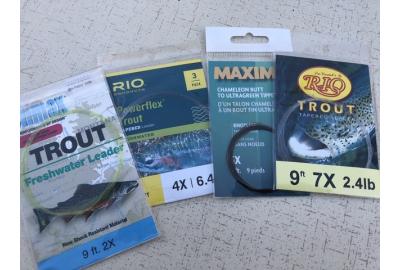Fly-Fishing Leaders - Keep It Simple
Leaders are the all-important invisible connection between your fly line and your fly. Understanding this link should be easy but, as so often happens, the near endless number of available options, each designed with a specific application in mind, often serve to confuse anglers rather than making their choice easier. Selecting an appropriate leader doesn’t have to be a baffling affair.
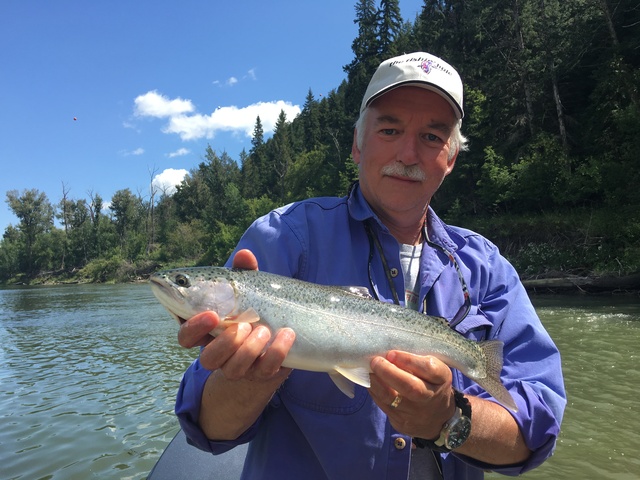
Trout fishing success comes, in part, from selecting the right leader.
Dry Fly Angling
Leaders are a key link in how you present any fly, but are most important when casting dry flies. If your fly was attached directly to your fly line, it would crash down onto the water, spooking every nearby fish. When dry fly fishing, a leader’s primary purpose is to help your fly settle onto the water softly and naturally, in a manner that won’t alarm fish. What you’re looking for when casting dry flies is a knotless tapered leader. Tapered leaders, as the name suggests, are thick at the butt section, narrowing in diameter to the tip. The taper allows the fly to "turn over", thus helping your leader straighten out when it settles on the water; if you’re still learning to fly-cast (by the way, it’s a lifelong process of continual improvement), you undoubtedly know the frustration of your fly, leader and fly line landing all together in a tangled heap. There can be several reasons for this, usually related to your casting motion, but a tapered leader is essential in helping ensure your leader and fly don’t pile up.

Tapered leaders helps ensure your leaders straighten out when you cast.
Most, though not all, store-bought leaders are knotless. Knotted leaders tend to be home-made. It’s more economical to make your own leaders if you go through enough of them, I suppose, but knots have a way of "catching" your fly or the leader itself when you’re casting, again resulting in a tangled mess. My advice is to stick to commercial, knotless leaders. For your leader to perform as intended, it’s critical that it be matched to the size of your fly. Leaders are sold with an "X" designation - 3X, 4X, 5X, etc. It’s not really important to know exactly what those designations mean. What is important, however, is to understand that the larger the number, the smaller the diameter of the tip end of the leader. And, everything else being equal, the lower the breaking strength of the leader.
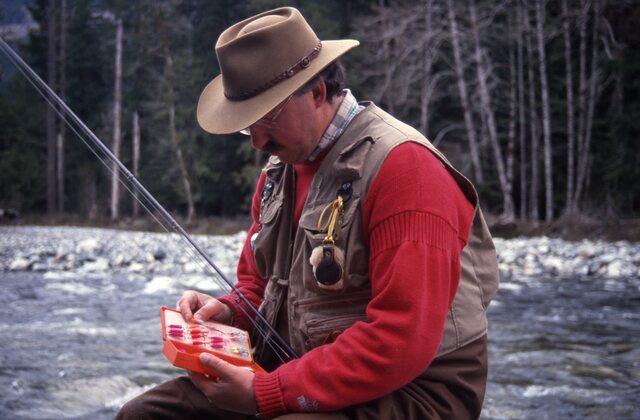
Be sure to match your leader to the size of your fly.
So how do you know what "X" designation to use? The simple rule of thumb is to divide the size of the fly by four. So, as an example, if you’re using a size #12 fly, the appropriate leader is found by dividing 12 by 4. 12 divided by 4 = 3X. When it comes to leader length, you’ll find that the most popular commercial lengths available are 7 ½-foot, 9-foot and 12-foot. For the vast majority of dry fly scenarios for beginning and intermediate fly-fishermen, a 9-foot leader is ideal.
It’s important to talk for a moment about "tippets". A tippet is a length of line that you tie to the end of your leader; your fly is tied to the tag end of the tippet. The primary purpose of a tippet is to extend the life of your leader; without a tippet, every time you change flies you lose a short section from the end of your leader and it quickly becomes too short and thick to be effective. To compensate for this, you add a short length (usually about 3-feet) of tippet material. Like leaders, tippet material is most often sold using the "X" designation method, but can also be sold using a breaking strength designation.
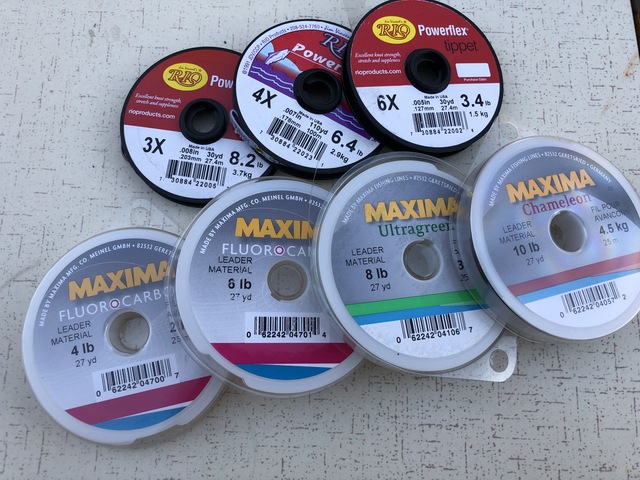
Tippet material is available with either an "X" designation or its breaking strength.
My recommendation is to start fishing with a 9-foot leader of the appropriate "X" designation. As you change flies, and as your leader shortens, add a section of tippet. Alternatively, you can start fishing with a 3-foot length of tippet tied to the end of your 9-foot leader. Be aware that longer leaders can be a bit more difficult to cast, however, particularly on small streams. One of the benefits of fishing with a short section of tippet attached to your leader is that it’s easy to switch out the "X" designation of your tippet as you change fly sizes.
Nymph Fishing
Tapered leaders are not essential when nymphing because delicate presentations are not required. Having said that, many anglers find they tangle less frequently when casting a tapered leader whether fishing nymphs or otherwise, so I recommend using commercial tapered leaders. More advanced anglers may choose to tie their own nymph leaders. For most nymphing applications, 7 ½-foot leaders will suffice. The rule of thumb when nymphing is to use a leader length 1.5 times the depth of the water you’re fishing. Remember that when nymphing, you generally want your fly at or near the bottom. So, if the water is four feet deep, you want your leader to be about six feet long (4 x 1.5 = 6).
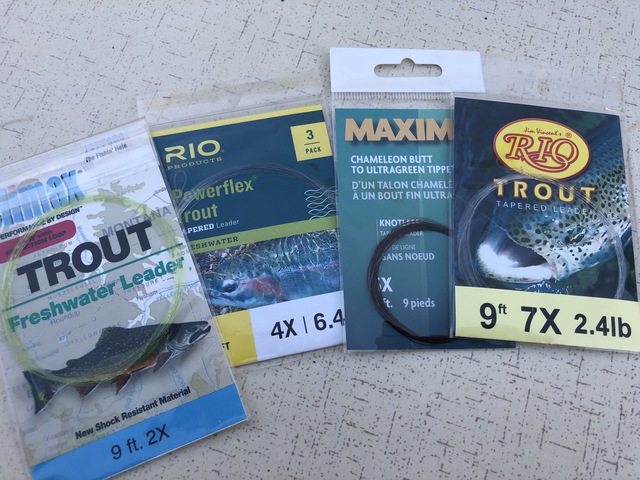
Most fishing retailers offer a range of leader sizes and lengths.
The exception may be in some of our larger rivers and in lakes, where the water you’re fishing may require a much longer leader. For these applications, select a commercial 9- or 12-foot leader and add tippet material to whatever length is required to get your fly to the desired depth. Longer, commercially-built leaders are available for these applications, though they’re not found in all fishing retailers.
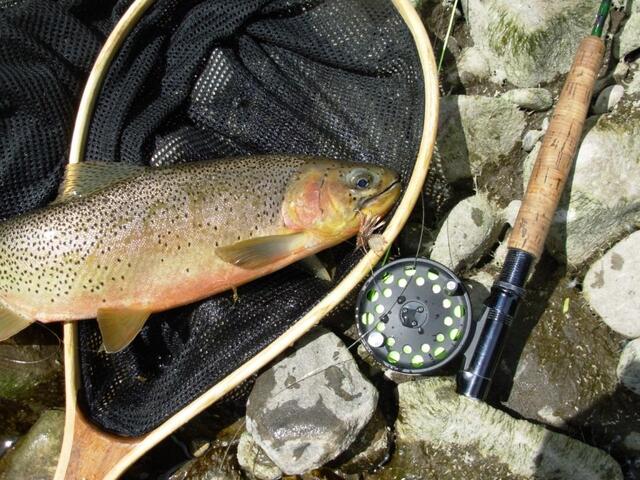
Leaders are the invisible link between your fly line and your fly.
When nymphing you’ll be using a strike indicator of some description. There are many designs of strike indicators and all work. For this discussion, think of them as "bobbers", in that one of their benefits is that they can be used to control the "active" length of your leader. As an example, if you have a 9-foot leader and are nymphing in four feet of water, you only need the last 6 feet or so of your leader (remember the 1.5 x depth rule). In this situation, affix your strike indicator 6 feet above your nymph and you should be good to go.

